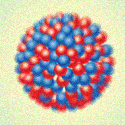Error tracking
The measured masses of over 2000 nuclei can be fit to a variety of nuclear models by varying the parameters of these models. The rms deviations of the fits are of the order of 0.6 MeV (relative to the ~ MeV energy scale of interest). However, the predictions for masses that have not been measured vary greatly from model to model. This poses a clear problem for making predictions in, for example, the r-process path for nucleosynthesis, which involves nuclei that are far from the line of stability and whose masses must be extrapolated from fits to known nuclei.
In a paper appearing in Physical Review C, Jussi Toivanen, Jacek Dobaczewski, and colleagues at the University of Jyväskylä in Finland present a method for estimating the uncertainties in the predictions for the masses of unmeasured nuclei. The procedure is based on standard statistical methods for varying only well-determined, linear combinations of the parameters in a model. The authors also distinguish between exact models, where experimental errors dominate, and inexact models, where the theoretical fit is poorer than the experimental error. The latter is the case for nuclear masses.
Taking a microscopic-macroscopic model based on the liquid drop model with shell-correction energies, they give a series of illustrations of what the nuclear mass fits look like when the number of parameters in the model for the shell corrections is successively restricted. They also illustrate how the data can be weighted to emphasize the importance of certain classes of nuclei, for example, light versus heavy nuclei.
The bottom line of the work is that greater care should be taken to estimate the reliability of extrapolations using mass fits. – John Millener





